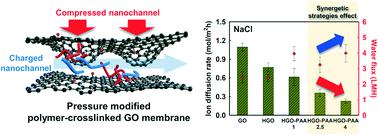当前位置:
X-MOL 学术
›
Environ. Sci.: Nano
›
论文详情
Our official English website, www.x-mol.net, welcomes your
feedback! (Note: you will need to create a separate account there.)
Synergetic effect of physicochemical and electrostatic strategies on ion sieving for polymer cross-linked graphene oxide membranes
Environmental Science: Nano ( IF 5.8 ) Pub Date : 2021-09-24 , DOI: 10.1039/d1en00613d Ki Ryuk Bang 1 , Daniel Bahamon 2, 3 , Lourdes F. Vega 2, 3 , Eun Seon Cho 1
Environmental Science: Nano ( IF 5.8 ) Pub Date : 2021-09-24 , DOI: 10.1039/d1en00613d Ki Ryuk Bang 1 , Daniel Bahamon 2, 3 , Lourdes F. Vega 2, 3 , Eun Seon Cho 1
Affiliation

|
Layered-stacked graphene oxide (GO) membranes have shown ultrafast water permeability and ion selectivity by virtue of their well-defined nanochannels and intrinsic surface charge properties; however, the accumulation of water molecules in GO capillaries makes it difficult to sieve monovalent ions, despite having narrow channels in the dry state. Here, pressure-controlled nanochannels in polymer-crosslinked GO membranes are designed for improving ion blocking performance as well as achieving high water permeability. The layer-connected architecture is created by amide bonds formed between hyper-branched polyethylenimine (HPEI) and polyacrylic acid (PAA). As the layer-stacked channel of this obtained HPEI-GO (HGO) membrane is susceptible to the applied pressure that can forcibly reduce the broadened interlayer distance, it is possible to create rigid cross-linked structures with a controllable channel size. Therefore, the highly compressed nanochannel with zwitterionic charged properties effectively suppresses the permeation of ions with a NaCl permeation rate of 0.2268 ± 0.033 mol m−2 h−1, which corresponds to 4.8-fold improvement over the pristine GO membrane. In addition, as the inserted PAA morphology changes depending on the pressure, the linear shape of PAA inside the narrowest channel exposes more functional groups which can participate in hydrogen bonding, leading to the increased water flux contrary to the trade-off relationship. Self-diffusion coefficients of water and ions and binding energy calculated by molecular simulations provide further insights into their behaviour in the nanochannels. It is anticipated that this strategy which combines physicochemical and electrostatic modifications can be exploited for tuning nanochannels of 2D-based membranes to achieve simultaneously fast water permeability and ion rejection.
中文翻译:

物理化学和静电策略对聚合物交联氧化石墨烯膜离子筛分的协同作用
分层堆叠的氧化石墨烯 (GO) 膜凭借其明确定义的纳米通道和固有的表面电荷特性,已显示出超快的透水性和离子选择性;然而,尽管在干燥状态下通道很窄,但 GO 毛细管中水分子的积累使得单价离子难以筛分。在这里,聚合物交联 GO 膜中的压力控制纳米通道旨在提高离子阻断性能以及实现高透水性。层连接结构是由超支化聚乙烯亚胺 (HPEI) 和聚丙烯酸 (PAA) 之间形成的酰胺键创建的。由于这种获得的 HPEI-GO (HGO) 膜的叠层通道容易受到施加的压力的影响,这可以强制减小加宽的层间距离,可以创建具有可控通道尺寸的刚性交联结构。因此,具有两性离子带电特性的高度压缩纳米通道有效地抑制了离子的渗透,NaCl渗透率为0.2268±0.033 mol m-2 h -1,相当于原始 GO 膜的 4.8 倍改进。此外,由于插入的 PAA 形态随压力而变化,最窄通道内 PAA 的线性形状暴露了更多可以参与氢键的官能团,导致与权衡关系相反的水通量增加。通过分子模拟计算的水和离子的自扩散系数和结合能提供了对其在纳米通道中行为的进一步了解。预计这种结合物理化学和静电修饰的策略可用于调整二维膜的纳米通道,以同时实现快速的透水性和离子排斥。
更新日期:2021-10-08
中文翻译:

物理化学和静电策略对聚合物交联氧化石墨烯膜离子筛分的协同作用
分层堆叠的氧化石墨烯 (GO) 膜凭借其明确定义的纳米通道和固有的表面电荷特性,已显示出超快的透水性和离子选择性;然而,尽管在干燥状态下通道很窄,但 GO 毛细管中水分子的积累使得单价离子难以筛分。在这里,聚合物交联 GO 膜中的压力控制纳米通道旨在提高离子阻断性能以及实现高透水性。层连接结构是由超支化聚乙烯亚胺 (HPEI) 和聚丙烯酸 (PAA) 之间形成的酰胺键创建的。由于这种获得的 HPEI-GO (HGO) 膜的叠层通道容易受到施加的压力的影响,这可以强制减小加宽的层间距离,可以创建具有可控通道尺寸的刚性交联结构。因此,具有两性离子带电特性的高度压缩纳米通道有效地抑制了离子的渗透,NaCl渗透率为0.2268±0.033 mol m-2 h -1,相当于原始 GO 膜的 4.8 倍改进。此外,由于插入的 PAA 形态随压力而变化,最窄通道内 PAA 的线性形状暴露了更多可以参与氢键的官能团,导致与权衡关系相反的水通量增加。通过分子模拟计算的水和离子的自扩散系数和结合能提供了对其在纳米通道中行为的进一步了解。预计这种结合物理化学和静电修饰的策略可用于调整二维膜的纳米通道,以同时实现快速的透水性和离子排斥。











































 京公网安备 11010802027423号
京公网安备 11010802027423号